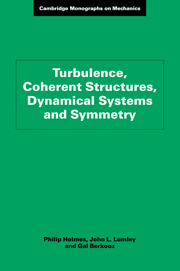6 - Symmetry
Published online by Cambridge University Press: 03 February 2010
Summary
Physical systems often exhibit symmetry: we have already remarked on the symmetries of spanwise translation and reflection in boundary layers and shear layers and of rotations in circular jets. One could cite many more such cases. Of course, symmetric systems do not always, or even typically, exhibit symmetric behavior and the study of spontaneous symmetry breaking is an important field in physics. These physical phenomena have their analogues in dynamical systems and in particular in ODEs, as we describe in this chapter.
The theory of symmetric dynamical systems and their bifurcations relies heavily on group theory and especially the notions of invariant functions and equivariant vector fields. The major references are the two volumes by Golubitsky and Schaeffer and Golubitsky, Stewart, and Schaeffer. In this chapter, as in the last, we shall attempt to sketch relevant parts of the theory using simple examples and without undue reliance on abstract mathematical ideas.
We have already met symmetric ODEs, in our discussion of the Lorenz equation (5.56) for example. This equation remains unchanged under the transformation (x1, x2, x3) → (−x1, −x2, x3), which corresponds to rotation of the phase space about the x3-axis through an angle π. This implies that, when the equilibrium 0 changes stability type from sink to saddle as ρ passes through 1, the resulting bifurcation is a pitchfork (see Equation (5.50) and Figure 5.8). Moreover, the global behavior, determined in part by the structure of the unstable manifold Wu(0) as we saw at the close of Chapter 5, is also influenced by symmetry in that the “left” and “right” branches of Wu(0) are mapped into each other by the symmetry.
- Type
- Chapter
- Information
- Turbulence, Coherent Structures, Dynamical Systems and Symmetry , pp. 201 - 226Publisher: Cambridge University PressPrint publication year: 1996

